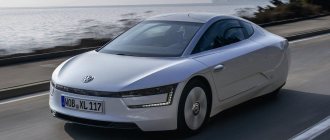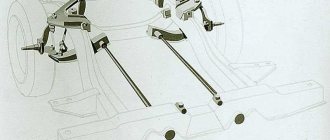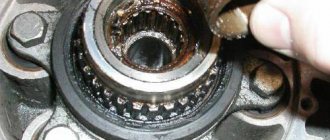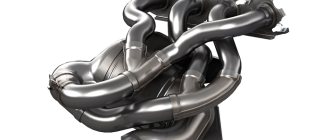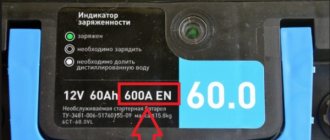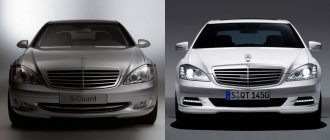What does the environmental class of a car show?
At the beginning of 2022, St. Petersburg took second place in the country in the anti-rating of cities with the dirtiest air - and this taking into account that the city has a small number of industrial facilities. The reason is the large number of cars that poison the air with exhaust gases.
What does the environmental class of a car show?
The European standard, which obligated manufacturers to modernize models and established a certain environmental class for the car, significantly reduced the amount of emissions into the atmosphere, but did not completely solve the problem. What is the environmental class of a car and what does it affect?
It is estimated that one average car per year with a mileage of 10,000 km consumes 4,100 kg of oxygen from the atmosphere and emits more than a ton of toxic substances, including lead, carbon monoxide and its compounds, sulfur dioxide, etc.
The environmental class of a car is a conditional gradation that reflects the amount and intensity of toxic waste that the car emits into the air. Today, automakers are required to comply with environmental standards and equip their vehicles with technologies and devices that reduce toxic emissions.
All vehicles today have a certain eco class or Euro standard, which depends on:
- year of production;
- fuel used;
- model, brand, country of origin;
- the presence of filter systems in the design.
Taking this into account, the car is allowed or prohibited to be used on the roads, brought into the country, crossed green areas, etc.
In 2022, the maximum environmental class for the Russian Federation is fifth.
Subtleties of increasing or decreasing the environmental class of a car
The operation of a car is never complete without replacing parts. Spare parts (namely catalysts) for cars of Euro-3, 4, 5 classes are not cheap, so car owners often refuse them. As a result of this restructuring, the car receives the first or second class of environmental friendliness. In our country there are no standards for regulating this kind of transformation.
If the environmental class of a machine is upgraded, re-equipment is carried out, after which a corresponding document is issued. If you have an old PTS and worn-out license plates, it is better to replace the entire set: new passports will already contain marks of an increased environmental class.
History of Euro certification
By the beginning of 1990, the purity of the atmosphere on the planet had catastrophically decreased. Cars running on gasoline and diesel engines were recognized as the most harmful to the environment. In 1992, a special regulation was developed in Europe, called the protocol for limiting the level of atmospheric emissions from road transport.
The first protocol was called Euro-1; the document specified the parameters of toxic emissions that were allowed to be emitted by cars.
Russia is a signatory to the Convention on Road Traffic adopted in Geneva. All restrictions prescribed in European environmental standards apply on the territory of the country.
The protocol is reviewed annually and the amount of permissible emissions is reduced. When developing the protocol, the following substances that constitute the concept of “vehicle emissions” are taken into account:
- Particles included in exhaust gases.
- Evaporation from a specific type of fuel.
Results
One of the indicators that influences the applicable transport tax rate may be the environmental class to which a particular vehicle belongs. Whether to use it depends on the decision made when setting rates in the region.
The class number is indicated in the PTS of a modern vehicle in a specially designated line. If the PTS is issued on an old form, then information about the environmental class number may be reflected in the “Special notes” column.
Sources:
- Tax Code of the Russian Federation
- By decision of the Customs Union Commission dated 09.12.2011 No. 877
You can find more complete information on the topic in ConsultantPlus. Free trial access to the system for 2 days.
How many environmental classes are there for a car?
- The first standard by which cars equipped with a gasoline engine were classified, Euro 1, began to operate in Europe in 1992. The protocol set minimum emission requirements. In the Russian Federation, the Euro-1 standard worked until 2005.
- The Euro-2 protocol was developed for EU countries in 1995; in the Russian Federation, the standard began to operate in 1999, along with the Euro-1 protocol. According to the protocol, the permissible level of emissions into the atmosphere was reduced by 100%, and fuel evaporation standards were tightened by 50%. Today, there are practically no cars with such a level of emissions - the engines are either recycled or modernized to a minimum percentage of emissions.
- The Euro 3 standard operated in the EU until 2004. The regulations included standards for both gasoline and diesel engines. For Russia, the protocol remained valid until 2013.
- Euro 4 was next. New amendments to the environmental class standard for cars were adopted in 2005. The Russian Federation joined the protocol in 2010. The standard tightened the amount of emissions and reduced the emission allowance standards by 40% compared to the previous protocol. Euro-4 was in effect in Russia until 2016. According to the standard, vehicles with an environmental safety class lower than Euro-4 could not be imported into the country. Manufacturers were required to upgrade engines in accordance with the protocol. Maximum emission standards for Euro 4:
- carbon dioxide - 4 g/km;
- carbon compounds - 0.55 g/km;
- solid carbons - 2 g/km.
- Euro-5 is the latest eco-standard that has been operating in the Russian Federation since 2015. European countries have been using the regulation since 2008. Since 2016, the import of cars lower than Euro 5 into the country has been prohibited.
Toxic emissions from cars into the atmosphere
Today there are restrictions on the entry onto public roads of cars whose environmental class is lower than that established for a certain zone. To increase the current eco class of a car, you need to:
- legally convert the engine;
- obtain an environmental inspection certificate;
- make appropriate amendments to the vehicle documentation at the State Traffic Safety Inspectorate.
Where it all started
Since the environmental situation was terrible at the end of the 20th century, in 1992 the European Union countries adopted a list of regulations that regulated the concentration of toxic substances in automobile exhausts.
The first standard was called Euro 1. A few years later, a new declaration (Euro 2) was approved, which included stricter rules. Subsequently, thanks to the activities of environmental organizations, other European standards were adopted under numbers 3, 4 and 5.
In the Russian Federation, the Euro 2 eco-standard was first introduced in 2006. 2 years later, Euro 3 appeared, and in 2010, Euro 4. Currently, all cars imported into the Russian Federation must meet the highest Euro 5 standard.
It would seem that these documents were adopted at the level of the participating countries, and therefore do not concern ordinary citizens. Actually this is not true.
Note! No individual or legal entity can import a foreign car into Russia that does not comply with generally accepted standards.
Let's say a Russian bought a 2004 Opel in Italy and wants to transport it to his homeland. It will not be possible to issue a technical passport and register a vehicle in Russia, because in that year the Euro 3 standard existed on European territory, and in the Russian Federation at that time a higher one is used. Thus, you should pay attention to newer vehicles, on the release date of which the last class was introduced.
Why might you need an environmental class car?
You will need to find out what environmental class a car has if the model is bought abroad, imported into the country, or if you need to clear customs of a vehicle that has already been imported into the state.
Also, the constituent entities of the Russian Federation establish their own rules for collecting transport tax. The tax rate depends on the vehicle category, year of manufacture, and environmental class. There is no single tax rate in the Russian Federation; each region sets its own transport tax amounts.
In the transport tax return, line 110 in section 2 is reserved for indicating the environmental class. In addition, to accurately determine the environmental class of the car you will need:
- To understand which roads you can travel on legally.
- Is it necessary to convert the exhaust system to a higher one?
The exception is transport, which is considered self-propelled vehicles, i.e. The maximum speed of such a vehicle does not exceed 40 km/h.
Ecology and transport tax
Taxation of transport is part of environmental legislation. The amount of mandatory payments is affected only by the engine power. It is worth noting that owners of cars powered by electricity are exempt from paying transport tax.
Subsequently, the main criterion determining the amount required to be paid will most likely be the environmental class of the vehicle. It is planned to introduce a fee of the same name. The higher the car’s safety index and the less its operation affects the environment, the better the savings.
This rule has long been relevant for most economically developed countries. Since the environmental situation remains difficult, the issue of protecting the atmosphere, flora and fauna occupies a leading position in the automotive market. It is important to remember this when planning to purchase an environmentally friendly car in the future abroad or in the Russian Federation.
How to find out the environmental class of a car
There are several ways to check the environmental class of your car:
- study PTS;
- registration certificate;
- by VIN;
- through online services of government agencies.
According to STS
Only owners who have a new type of document in their hands have the opportunity to find out the environmental class of a car from the car’s registration certificate. In the new certificates, the environmental class is written in letters in the corresponding column; drivers comply with the requirement of signs 5.35. 5.36, 8.24 (passage of cars of the corresponding eco class).
Owners of the old certificate must exchange the STS, the effect of restrictive signs will apply to them from July 1, 2021.
According to vehicle title
In the PTS of the new model, the environmental class of the car is indicated in the 13th position. In old-style documents, the parameter may be on a different line; for some, the auto class is not set. In this case, the car is assigned a zero standard or Euro-1.
Through Rosstandart
The Rosstandart portal provides detailed data on manufacturers and summary tables of vehicle eco-class compliance by country and year of manufacture. Just go to the service and view the information you are interested in.
“Green” cars – saving the environment
In addition to the table by country and manufacturer, the service provides vehicle characteristics by make and model. The motorist needs to open the “Approval Information” page, enter the model and view the characteristics of the vehicle.
For example, for the Audi A8 the approval number is CU RU E-DE.AYA04.00070.P5I1, assigned Euro-5.
By VIN code
An effective option remains to check a specific car by VIN code through the environmental classes of Rosstandart cars. An electronic database for vehicle owners is provided on a separate page. 17 code characters are entered into a separate window; after a few minutes, the car owner receives detailed information on the model indicating the environmental class of the car.
If the manufacturer has not entered data on the emission standards that are present on a particular car, you must contact the State Traffic Safety Inspectorate with an application to assign a specific eco class after upgrading the car.
What to do and where to go?
So, you opened the PTS and did not find column 13 and no special marks or saw that “the environmental class has not been established.” In this case, it is necessary to enter information about the environmental class in the “Special Notes” in the PTS. Only registration departments of the State Traffic Safety Inspectorate have this right, but to do this you must provide a document confirming that your car actually complies with this environmental class. And here the burden of proof falls entirely on the owner. How to prove it? It is immediately worth noting that today not a single regulatory document gives a clear (read, any) answer to this question. Thus, the currently valid Technical Regulation of the Customs Union TR CU 018-2011 “On the safety of wheeled vehicles”, which defines the technical requirements for automotive vehicles and the procedures for confirming compliance with these requirements, in no way regulates the methods of confirming environmental safety for cars that already issued for circulation on the territory of the countries of the Eurasian Union (including Russia), with the exception of the technical inspection procedure. And since the car has a PTS, it means that it has already been released into circulation, since the date of release of the vehicle into circulation is the date of the initial issue of the Russian PTS.
But a technical inspection does not help here either, because according to Appendix No. 8 (clauses 9.1, 9.2) to TR CU 018-2011, in order to assess the performance of the engine and its exhaust systems in terms of emission standards, it is necessary to indicate the environmental class of the vehicle being tested in order compare actual emissions with acceptable values. That is, it is impossible to establish during the technical inspection what you should know in advance. The curious thing about this situation is that all cars whose environmental class is not indicated in the documents undergo technical inspection in violation of the requirements of TR CU 018-2011, i.e. illegally. And since such cars are a dime a dozen in our country, it is obvious that at least once almost every maintenance operator has issued a diagnostic card for such a car. However, everyone turns a blind eye to this...
But let's return to the proof process. Obviously, the absence of clear requirements for establishing an environmental class thereby creates an incredible corruption component, including a free hand for the traffic police, who begin to demand various types of evidentiary materials from owners. It is interesting that there is a list of documents that can be accepted for consideration for entering information about a vehicle; it is present in paragraph 39 of the “Regulations on vehicle passports”. It says that this information is filled out “... on the basis of OTTS, SBCTS, and in their absence ... on the basis of officially published technical specifications, reference books, tables and other documents.” Let's figure it out in order. So, where can a simple car owner get OTTS ? The original of this document is kept either by the manufacturer (for Russian-made vehicles) or by its official Russian representative office (for vehicles manufactured outside the Russian Federation). The only problem is that manufacturers and their representatives rarely issue certified copies of their approvals to car owners. This is understandable: in their opinion, OTTS is an internal document, and its content is a commercial secret, and therefore it can only be officially requested at the request of supervisory authorities. Unfortunately, the traffic police are in no hurry to bother themselves with these requests, and interested vehicle owners are practically deprived of such an opportunity.
Meanwhile, there is one problem that emerges after you have managed (if you have managed!) to get a copy of the OTTS that applies to your car. If you, for example, have a 15–20-year-old “European”, then in his approval issued by the State Standard of Russia in the same years, information about the environmental class will be indicated indirectly - in the table of Appendix No. 1 (Summary sheet) in the form of “ecological » UNECE Rules with one or another amendment, confirmation of compliance with the requirements of which will denote the corresponding “Euro”. But this identification can only be carried out by a certification specialist. The “traffic cop”, having not found the column “Environmentally class” on the title page of the OTTS (let me remind you, it appeared only in OTTS issued since April 21, 2006), in 99% of cases he will say that such type approval is not suitable. This means that you will have to apply for an examination that will confirm the availability of information about a specific environmental class in a specific OTTS (more on this later).
The second document is SBCTS (vehicle safety design certificate). This is a relatively recent certification document that appeared in connection with the entry into force in September 2010 of the first (still Russian) technical regulation on the safety of wheeled vehicles (approved by Decree of the Government of the Russian Federation No. 720 of September 10, 2009). SBKT is issued for single vehicles, including used ones, which are imported from abroad. For our topic, this document is of little relevance due to the youth of this procedure and due to the fact that if an SBCTS was issued for a car, it means that a PTS was also issued on the basis of this certificate. And if so, then the environmental class must be specified in the passport. Sometimes the demands from individual traffic police officers to confirm the environmental class to provide an SBCTS for a car, say, 1998, for which the Russian title was issued, for example, in 2003 (i.e., a used foreign car was imported) sometimes seem completely stupid, since a certificate is issued for a car to obtain permission to put it into circulation, and the release into circulation is the issuance of a PTS. Consequently, permission to release into circulation cannot be obtained after the release has already been officially made.
Now let's turn to the official reference books, characteristics and tables. This very vague definition is generally understood by all industry specialists. To put it into simple language, the vehicle owner can make an official request to the manufacturer and his representative, who will respond in writing that such and such a specific car with such and such a VIN code, according to the manufacturer, has such and such an environmental class . Such official letters are written in batches, and most often manufacturers/representative offices do not take any money for this (though not all of them - some still try to speculate on this and have approved price lists for such a service). In fact, this is the easiest way for the owner, if not for one “but”. When the first environmental restrictions first appeared in Moscow, many owners, in order to get around them, presented such certificates with a “slightly overestimated” environmental class to the traffic police. It is not clear how this happened: either the letterheads and seals were forged, or for an unofficial “reward” the manufacturers acquiesced and attributed extra money. But such facts were revealed, and, as they say, in considerable quantities. Since then, employees in uniform have had nothing to do with these certificates and send the owners for OTTS or for examination.
An expert opinion is the very option that is hidden behind “other documents” . Now the Internet is replete with similar offers. Most often, small commercial offices offer to “install” the required environmental class for money (currently the maximum required is “third”, but for some people “second” is enough), issuing beautiful pieces of paper with loud names like “Ecological Certificate”, “Certificate of Environmental Safety” etc. - who knows what. The technical supervision of the traffic police also knows about this, so they usually send a similar conclusion to more or less reputable organizations, for example, NAMI. Such a conclusion can be very relevant if it is not possible to find the OTTS on your own or if the environmental class is not specified on the title of the OTTS.
The whole problem is that, unfortunately, the simultaneous presence of OTTS, an expert opinion and even a letter from the manufacturer does not at all guarantee that the traffic police will put an environmental class mark on your PTS.
There is talk behind the scenes that they are now simply afraid to do this, since there is an unspoken order from above to clear the market of old “rydvans”. Of course, this is, to put it mildly, not entirely legal. Therefore, if you are faced with a refusal from the traffic police in the presence of documents confirming the environmental class, then the only way to resolve the conflict is to go to court. The chances of success here are really high, because any refusal will have to be argued in the legal field, and the traffic cops, as a rule, have nothing to cover up here. UNECE rules regarding environmental safety of vehicles and their applicability
| UNECE Regulation No. | Vehicle category | engine's type | Object of rationing |
| 24 | M, N | Diesels | Visible pollutants (particulate matter, soot - PT) |
| 49 | M1, M2, N1 N2 (control weight over 2160 kg) and M3 N3 | Diesels and gas engines (LNG and CNG) | Gaseous pollutants (CO, CH, NO) |
| 83 | M1, M2, N1 N2 (control weight not more than 2160 kg) | Diesels, petrol and gas | Gaseous pollutants (CO, CH, NO) |
| 96 | Tractors and off-road mobile equipment | Diesels | Gaseous (CO, CH, NO) and visible (soot) pollutants |
Fines in the Russian Federation for violating the standard
Today in the Administrative Code there is no article regulating the compliance of a vehicle with one or another eco class. Violators of environmental parameters are fined according to the list of parts of Art. 12.16 Code of Administrative Offenses, “Failure to comply with the requirements prescribed by traffic rules.” Namely:
- Violation of the “Left Turn” sign, Art. 12.16 p.2 fine – from 1000-1500 rubles.
- Movement of freight transport in the presence of a “No passage” sign, Art. 12.16 p.6., fine – 500 rubles. (except Moscow and St. Petersburg). If the violation occurs within these cities, the fine increases to 5,000 rubles.
- Art. 12.16 part 1 indicates that for any violation of the requirements of road signs, the driver will face either a warning or a fine of 500 rubles.
From 2022, the environmental class of a car will become a decisive factor in possible restrictions when driving on roads of a certain category. Car owners are recommended to replace the STS with a new document now and purchase cars on the secondary market that are at least Euro-4.
An exception
These standards do not apply to special equipment, the registration of which does not issue a PTS, PSM (passport for a self-propelled mechanism). A mandatory condition is the maximum possible speed on the highway is 40 km/h. Officials probably believe that diesel bulldozers and excavators will not harm the ecosystem when operating within, for example, a construction site. Well, a speed of 40 km/h makes the exhaust as clean as the morning breeze. This is for units whose diesel fuel consumption is 100 liters per hour of operation.
Where to get information about your car
So, what practical benefit can a table that determines the environmental safety class bring us? Another question is where can one get this information?
It turns out that each car crossing our border is given the corresponding data in the vehicle passport (PTS) in section 13 or in “Additional notes”. That is, just look at the registration certificate to find out how safe your car is?
Absolutely true, and this is not the only option for defining environmental safety. There is also a Rosstandart database, although not everyone uses it yet. The so-called method is more popular in search queries: by VIN code, or in other words - by individual body or frame number. You can find it in different places of the body - this could be the engine compartment, door sills, dashboard and other areas, depending on the model.
This option is considered the most accurate and at the same time simpler in terms of implementation. There are special online services, which, however, are still connected to databases. We indicate the VIN number and receive reliable data, namely:
- vehicle brand;
- year of issue;
- category (class) of environmental safety, etc.
Differences between Euro 5 gasoline
EURO-5 fuel differs from its predecessors in its lower content of heavy metals and various impurities. In general, EURO 5 gasoline releases much less harmful substances when burned. This reduces exhaust toxicity. Now almost all gas stations that comply with the law sell Euro-5 fuel. By purchasing it, you can be sure of high quality fuel.



